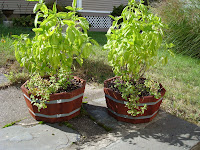My plan is to build a small wooden box around the kale and fill it with about a foot of organic mulch before the Big Freeze really settles in. Through out the winter, I'll occasionally harvest small quantities of kale, water during the warm spells, and see if I can keep this process going through out January, February, and into March.


Kale row in a sunny part of the yard


The afternoon sun is casting long shadows now, as demonstrated by a tall weed growing through the walkway; this is by far the sunniest part of the yard year-round, and the future site of a large, bordered herb garden
While looking over some of the containers out front, I couldn't help but notice that the pollinators that had been so busy merely a month ago are all gone now. With the exception of a few very small flies flitting around the flowers, there was no more of that frantic activity during the sunny hours of the late mornings and afternoons that I had come to enjoy so much. Of course, winter is nearly upon us, and the bees are done collecting their pollen, having stored it all away in anticipation of the vernal birth of the next generation of their bee progeny.
However, I did come across one honey bee -- extremely large and lathargic, he appeared to be completely sacked of energy from the recent cold spell. He wasn't flying, rather just crawling around on one of the containers. It looked like he wanted a comfortable location to camp out, so I managed to get him to cling to a small twig, and placed the twig just below a canopy of salvia. He was still sluggishly exploring the contours of his twig when I wandered off to do a few other things.
Later, I returned to the salvia, and he was gone. Perhaps he had some other spot in mind to begin his journey into that good night. Meanwhile, down the street, and away from the house, I could hear the murmurings of the busy inhabitants of my own eco-system -- children and their parents, gradually emerging from their homes, to enjoy this relatively mild evening and the celebration of yet another All Hallows Eve.
This day is done, and the darkness falls from the wings of Night
- Longfellow























